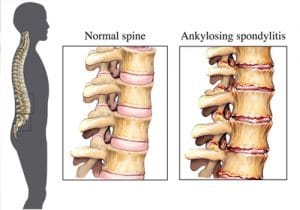
Ankylosing Spondylitis
It is a persistent inflammatory ailment that affects the vertebral joints. It makes the backbone stiff however also can irritate different parts of the body such as the eyes and blood vessels.
It has symptoms like weight loss, fevers, and fatigue. If it attacks sacroiliac joints, causes buttock pain and if it affects the cervical or thoracic region it can cause back pain and stiffness because the ribs and vertebrae are involved.
Ankylosing Spondylitis Treatment
Ankylosing spondylitis can be diagnosed using MRI or an X-ray/CT scan. Medication and physiotherapy can help fight the disease. In the worst-case scenario, you can opt for surgery.
Advance Explanation
Ankylosing Spondylitis (AS) is a chronic inflammatory disease that causes pain and inflammation of the joints of the spine and the joints between the spine and pelvis (sacroiliac joints). However, AS may affect other parts of the body as well. AS and its related diseases affect as many as 2.4 million people in the United States. AS commonly occurs in people between the ages of 17-35, but it can affect children and older adults. AS is more common in men, but occurs in women as well. Although the exact cause of AS is unknown, research has ascertained that genetics, along with some environmental factors, play a key role in developing AS.
The first symptom of developing AS is frequent pain and stiffness in the lower back and buttocks, which comes on gradually over a few weeks or months. This pain and stiffness are usually worse in the mornings and during the night and improve with light exercises. Some patients with AS can also develop inflammation in their tendons and other joints of the body.
In patients with advanced AS disease, inflammation can cause the spine to fuse in a fixed, immobile position, sometimes creating a forward-stooped posture. The goal of treatment is to relieve pain and stiffness and prevent or delay complications and spinal deformity. Nonsteroidal anti-inflammatory drugs (NSAIDs) are initially used to reduce inflammation and pain. Other drugs used are sulfasalazine or methotrexate. These drugs, however, are not as effective in controlling inflammation in the spine. Newer drugs, called TNF-inhibitors have shown signs of improvement in the symptoms of AS. These include medications such as Humira, Enbrel, Simponi, and Remicade. Recently, research has found that these drugs control symptoms but there is still some residual inflammation seen on MRI of the SI joints in patients with AS. Symptoms reoccur after stopping these medications. There are ongoing trials to find more effective and longer-lasting medications for these patients.
The physicians at Regional Arthritis and Rheumatology Associates (RARA) treat a lot of patients with Ankylosing Spondylitis. We also have an infusion facility that provides Biologic therapy to patients with AS.
